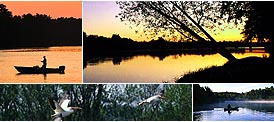
| Redfish | Sailfish | Sharks | Sheepshead | Snapper | Snook | Spanish Mackerel | Spotted Seatrout | Tarpon |

REDFISH (RED DRUM)
Regulations
Slot limit of not less than 18" or more than 27"; no closed season; one fish per person per day limit
General Information
This is one of the top recreational saltwater gamefish in the state. Redfish spawn from August to November in the offshore waters near passes and inlets. September is usually the peak month. Those that survive the open water larval fish stage, move into the estuaries as juveniles where they will live for several years. Anglers sometimes encounter large schools of these young fish, often called rat reds. The schools do migrate although scientists believe that they do not move over great distances.
Distribution
At one time the fish was in danger of being overharvested because of commercial activity. It's strong recovery led to the recent change that eliminated the closed season for this species.
The redfish's recovery from the brink of being wiped out is a direct result of its designation as a "restricted species" in 1989. This ended the commercial harvesting of the fish, a move that ultimately saved the species being wiped out by highly efficient offshore commercial netters. With the change of the redfish's status to a non-commercial species, stocks have been able to recover and the fish is now abundant in many parts of the state. Redfish are now common throughout the coastal waters and nearshore areas of the state. A stocking program in Biscayne Bay has also brought redfish back to this lower southeast coast are for the first time in nearly 30 years.
Tackle and Techniques
Anglers have a wide option when it comes to the tackle needed to catch redfish. When fishing the open waters of the flats try an ultra-light rod and 2 pound test line. It will definitely test your skill. A more conventional combination is a 6-7" rod with 12 to 15 pound test line with a 40 pound test leader. It will work on the flats, along mangrove shorelines, and in the deeper waters. In a corresponding fashion, fly fishers can use an 8 or 9 weight rig and make the fishing interesting by varying the tippets from 2 to 12 pound test.
Normally redfish move onto the flats to feed when the water temperature rises above 70 degrees. They will tolerate much higher temperatures but tend to remain there for less time as the water temperature approaches the upper 80s.
Tidal stage also has a strong influence on when redfish move onto the flats. The best time is during the first half of the flooding or ebbing tide. The fish's advantage over the angler at this time is water depth. You either need a very shallow draft boat which can be poled or run with a trolling motor or must wade onto the flat to get to the fish. Many anglers prefer to wade because redfish can see and hear boats. An angler walking through the water is much less obvious to a redfish.
When water temperature drops below 70 degrees, redfish abandon the flats and head for the slightly deeper and warmer waters of channels near the flats. The fish still get hungry so work the drop-offs until you find the fish.
Bait
Redfish grow fast. In one year most are a foot long. To grow that much redfish must do a lot of eating and most of it comes from what they pick up off the bottom. Stomach analyses reveal that their natural diet consists of small crabs and shrimp. This explains why shrimp is one of the most widely used baits.
Crustaceans may be what you find in the fish's stomachs but anglers know that with a voracious appetite, redfish will take a variety of other offerings. Small live baitfish, just about any jig, gold and silver spoons, and even topwater plugs are potential meals if they are presented correctly. Of these, the topwater plug is an interesting bait to use when fishing the flats because the fish must come to the surface and rollover to get its mouth in position to strike the bait.
Secrets to Success
* Redfish are very aware of what's going on above the surface of the water when they are on the flats. They can see and hear anglers, especially when they are in boats. This is why wading for them often results in more hook-ups than staying on the boat. Be quiet and keep a low profile.
* Sightfishing for redfish is one of the most exciting types of fishing for saltwater anglers. The principle of the technique is not to cast until you see the fish. You can locate them on the flats by looking for the fish's tail which breaks the surface when they stick their nose in the mud to feed (what anglers call tailing redfish) or when you can see the hump of water they push in front of them as the cruise across the flats.
When you find tailing fish wait for them finish eating and begin to move. As they swim away cast your bait ahead and past the fish. The idea is to have your bait intersect the fish's path and hopefully catch it's attention. When their nose is in the mud, the fish often cannot see your bait.
Redfish associate with stingrays. And stingrays, when they feed, stir up the bottom and create what anglers call a "mud." This highly visible sign should be an automatic signal to cast towards the muddy area. Redfish frequently hang around the rays looking for food that is stirred up by the rays.
Redfish don't move around too much. If you find fish on a flat or in a channel, it's a good idea to go back to the same spot the next day. Chances are good that the fish will be there again.












